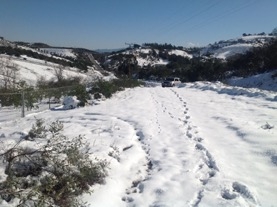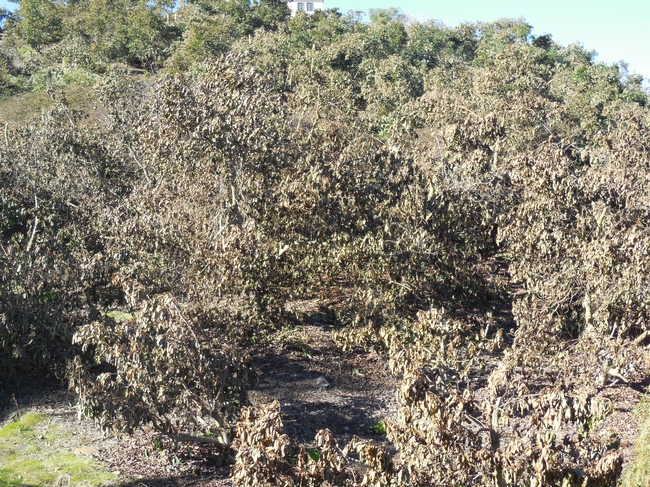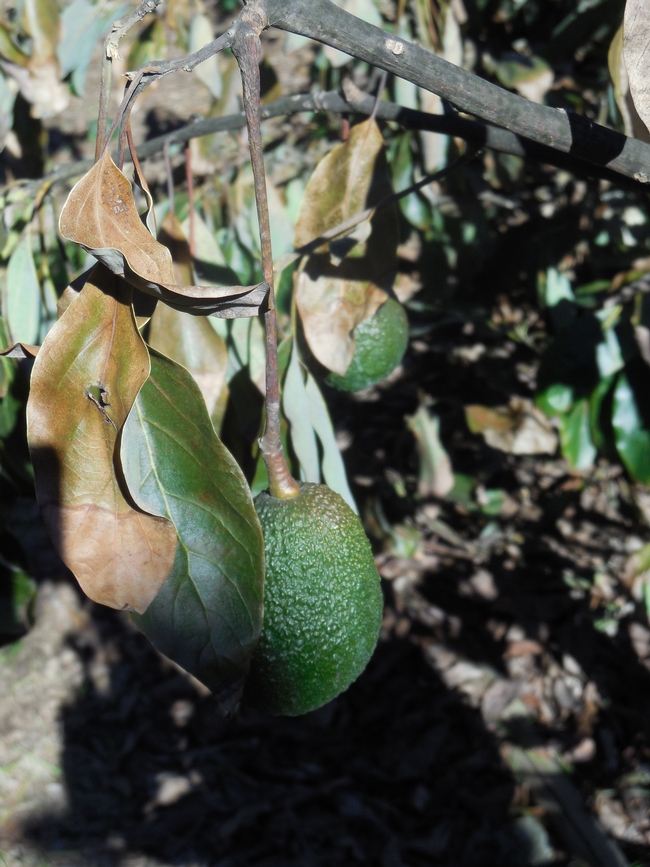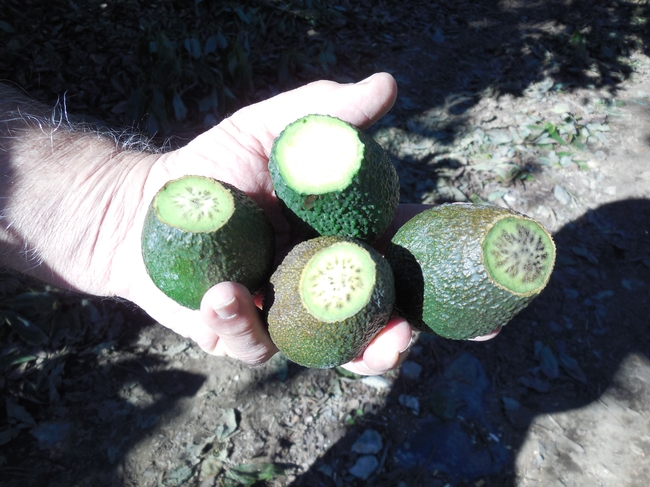More than 6 inches of snow fell on areas of Riverside County, part of the state's southern-most growing region, which produces nearly half of the nation's avocado supply. As much as a foot of snow fell on mountain ridges around Temecula and Murrieta the higher elevations of the De Luz area and surrounding region of San Diego and Riverside counties in late December 2014. The accumulation of snow snapped many limbs and branches. The cold and snow also damaged a significant amount of fruit. The De Luz area near Temecula was hardest hit in the higher elevations. It seemed. As if the storm blew in from the East. In some groves lost was estimated 80-90 percent and others we lost nothing. Over the next several weeks, some fruit on the trees turned brown or bronze indicating that it was also unmarketable.
Frost vs. Freeze
The avocado tree, while quite adaptable to a range of climatic conditions, is considered to be sensitive to frost. Growers in regions where frost is likely will need to consider this when designing the layout and irrigation of their orchard. It's important to differentiate between a frost and a freeze. There is a lot of science behind frost, but in basic terms, frost is the formation of ice crystals on plants which more importantly can lead to the freezing of internal sap. Frost is the result of climatic conditions that lead to sub-zero temperatures. A frost is caused when objects cool during the night and radiate their heat loss, chilling the surrounding air. Cold air tends to settle near the ground while warm air rises. In Southern California, the “ceiling” is often low, which means that warm air is closer to the ground. This phenomenon is called a temperature inversion and it tends to protect orchards from the cold. That said, when forecasts indicate windy conditions this disrupts the inversion and thus the colder air is pressed to ground level. Knowing whether a temperature inversion is present or not is a key factor in determining whether to use wind machines as a preventative measure.
A freeze occurs when a mass of cold air moves in and the temperature of the air decreases at both ground level and in the higher air levels. Protecting groves in these conditions is difficult and usually involves adding heat to the grove with orchard heaters. When grove temperatures are cold (generally below 60-degrees Fahrenheit) and the day is sunny, avocado leaves can stress and bleach or yellow because they cannot metabolize the light being received in such cold temperatures. The leaves produce hydrogen peroxide, which damages the leaves.
For California avocado growers, January is the month that groves tend to be susceptible to frost and freeze damage. As the threat of colder weather arrives, it's important for growers to understand the mechanics of frosts and freezes, and what they can do to protect their groves from unseasonably cold conditions. Be aware of temperatures falling below 30-degrees Fahrenheit, regardless of weather forecasts. Rather than rely on forecasts, establish a frost-management plan, and follow it.
Protecting Groves
To prevent frost damage in a mature grove, the two most-relied-upon methods are orchard heaters and wind machines.
As a guide to inexperienced growers, Table I gives a basis for establishing frost protection practices. The critical temperatures listed are for mature healthy trees. Other tree conditions might move these figures one or two degrees higher. Also, the duration of the damaging temperatures would affect the degree of injury.
|
Variety Frost Resistance |
||
|
Race |
Typical varieties |
Critical temperature below which fruit and/or trees are subject to damage |
|
Mexican |
Duke, Topa topa, Mexicola, Zutano, Bacon |
25 Degrees F |
|
Hybrids |
Fuerte, Puebla |
28 Degrees F |
|
|
Ryan, Hass, MacArthur, Nabal, Endranol, Rincon |
29 Degrees F |
|
Guatemalan (Very Tender) |
|
30 Degrees F |
Orchard heaters tend to distribute heat to all parts of the grove when well distributed but can be expensive to run and can present a fire hazard.
Wind machines are economical and less labor intensive and, when used with orchard heaters, can increase the effectiveness of the heaters. Wind machines should only be used in frost conditions — not during freeze conditions in which temperatures fall 4 or more degrees below damage points. In addition, wind machines should not be used in conditions (usually windy) in which no temperature inversion is present. If wind machines are used in these conditions, they can cause more damage because they simply stir up the cold air at tree level.
In situations in which there is no temperature inversion, the best practice is to run microsprinklers during the day and then turn off the water prior to sunset. As water freezes it gives off heat, so by providing water to freeze, you are generating heat. However, water cannot flow when it is frozen, so any under-tree irrigation systems must be started before the temperature gets to a point when the water freezes in the pipes or emitters. If temperatures drop below 32° during the night, the water should be started again and run until sunrise. Since it can be expensive to run water in San Diego County, growers can opt to choose those portions of their grove that tend to be the coldest in order to save money. When the temperature is below freezing, Dr. Faber recommends against running water in a block during the night and then turning it off to water another block as this will lower the temperature in both blocks and lead to damage. It should be noted that these methods are less effective for protecting young trees. To protect young trees, insulative wrap or frames with a burlap cover may be needed. Side and top cover is required to protect from frost, trunk guards can help prevent total tree death by protecting the main trunk.
Location, location, location! Choose a good growing location to minimize the chances of cold air. Cold air is heavier than warm air, so planting on a slope allows cold air to flow down and out of your groves. It is important to have space available for downhill air drainage of cold air. Trees that are planted more towards this area are more prone to damage, especially when the trees are young (up to 3 years of age) or if they have cold-sensitive cultivars. Orchard design is another important factor, aligning your rows to run up and down slopes rather than across slopes to allow effective air drainage. Cultivation practices can also help with battling frost. Maximizing tree health can also be beneficial for a grove susceptible to frost, a healthy, leafy tree will generate some internal heat and reduce the depth of frost burn into the tree. Unhealthy trees should be treated for root rot at the beginning of spring. If not properly treated, these trees will flower excessively in spring; but fail to grow new shoots. If the leaves yellow during winter, consider reviewing your nutrient program. Weed control is an important pest management routine that should be taken seriously. A strip of bare, moist earth under and around the trees will absorb and release heat more than a weedy or dry site.
Occasionally avocado trees are in a growth flush (a period of rapid new growth) when freezing temperatures occur. This is not usual, but unseasonably warm weather may stimulate a tree into abnormal growth in the winter. To avoid stimulation, pruning should be delayed until early spring. When tender growth occurs in the winter, growers may have to provide additional protection or sustain damage.
Caring for Frost Damaged Trees
Immediately after a frost event the main thing to do is carefully monitor your soil moisture. As the tree may have been significantly damaged, the amount of water it will be using will be reduced. The last thing you need is to damage the root system as well through waterlogged conditions. Trees stressed by wet soils may have premature leaf drop, bear small and pale green leaves, and show signs of avocado shoot die back. Too much water during this time can cause root rot. If trees lose leaves to frost/freeze, it's important to protect exposed branches from sunburn with whitewash. Initially all you can do is to let the trees start to recover naturally. Once they have started to re-shoot in spring, then you can begin the task of removing dead wood and shaping/balancing the tree.
Post Freeze Grove Management and Harvest
According the California Avocado Commission (CAC), after a freeze, California avocado growers should look for the following freeze indicators:
- Firm, brittle, curled leaves
- Water-soaked or discolored wood or twigs
- Older branches and trunks splitting and losing bark (this happened a lot during the snow event in 2015)
- Discolored avocados, with hues ranging from barely visible bronze to black
- Brown buds and flowers
- Fruit stems can be killed or ring barked, causing heavy-fruit drop
Soon after leaves fall, whitewash defoliated trees with white-latex or lime-based paint that is water diluted (not too diluted, as paint should appear white on tree). This will protect damaged wood from sunburn, which can cause further damage. Do not apply dressings — or additional paint-on sealants — to cracked bark, as it might strengthen bacterial or fungal infections. Pruning can be postponed until spring or summer, when new growth develops. Survey damaged trees before applying fertilizer, to identify what minerals are lacking, as nitrogen applications are likely to trend downward. It is suggested that avocado growers withhold nitrogen fertilization until midsummer (or longer). However, zinc sprays often are applied to expanding young foliage.
Stem-damaged fruit will drop within seven to ten days of a freeze, it should be picked first, assuming it is mature and not otherwise harmed by the cold. While stem damage may be apparent, fruit might be unscathed. When stems are completely girdled by a brown band, fruit will drop. Drops typically occur within seven to 10 days, following a freeze. Also, do not pick any discolored avocados (barely visible bronze to black).
Work Cited
- California Avocado Society. The Weekly Newsline: Market news, opinions & Statistics for Avocado growers. [http://www.californiaavocadosociety.org/] Accessed 7 January 2015.
- Dreistadt S. H. (2008). Integrated pest management for avocados (Vol. 3503). UCANR Publications.
- Witney, G. W., & Arpaia, M. L. (1991). Tree recovery after the December 1990 freeze. California Avocado Society 1991 Yearbook, 75, 63-70.



